At every turn, there is a new food/farm documentary coming out with sensationalist titles like GMO OMG and Cowspiracy. Thanks to the popularity of streaming sites like Netflix and the deep pockets of some interest groups, it has become easier than ever to get such a movie made. And that would be fine if there was any value and truth to what they show. These “documentaries” are too often light on substance and tap into very little — if any — reality about modern agriculture. And, as a farmer who is doing my best to build a sustainable and thriving operation, it’s crushing to see these kinds of depictions get so much buzz in popular culture.
Not long ago, I spoke to a teacher who had recently shown Food, Inc. to her class, and she asked me my opinion of Cowspiracy. I told her it was equivalent to what I shovel out of the cattle pens. I reminded her the purpose of a documentary is to document real-world experience, and even though most will be somewhat biased through the eyes of the filmmaker, these food and ag docs are most often marketed as the definitive answer on a particular subject matter (such as biotech, nutrition, or soil).
Consider a National Geographic documentary on crocodiles, for example. You don’t walk away saying, “Those crocodiles are evil and greedy; why do they kill so many buffalo and why do they trick them by pretending to be logs?” Of course you don’t, because the documentary director is just … well … documenting. You are shown crocodiles being crocodiles. Is their worldview rocked once they see the ferocity that crocodiles exhibit? Unlikely. The viewer simply learned that crocodiles have the most powerful jaws in the world and are attentive mothers who can hold their breath for an hour and go months without eating, along with many other previously unknown granular and informative tidbits. And even though crocodiles have been known to eat people or dogs, it is not natural or common. The film crew doesn’t throw children or puppies into a crocodile infested river for dramatic effect.
Why state the obvious? Because these food/farm docs are doing the opposite. They take the common world view of farmers feeding the masses and then scream, “Guess What! Not only are farmers not feeding you, they are actually poisoning you!”
Then they introduce the characters. These filmmakers are spot on with character development. The formula goes something like this: The first character introduced is the conventional farmer turned organic. Environment first, profit second — no tractors or technology to be found on this homestead. Character No. 2 is a vegan activist who was on the verge of death by eating meat and dairy and then they switched to veganism and is now living his/her healthiest life.
This highlights the importance of ideology within a doc, especially those pushing plant-based diets with a sprinkling of animal rights activism. The third character is a tech guru type or other professional who decides it’s time to get back to the farm, throws on some Muck boots and a North Face jacket, and promptly invests in a menagerie of heritage-breed livestock.

Character one and three I can somewhat relate to, as I have experienced a little of both. My dad had a small truck farm (he called it a really big garden), and we kept some livestock. My grandparents had a significantly larger truck farm and supplied small grocers with produce in the late 1970s and early ‘80s. Even though I left rural Indiana for the suburbs at age 12, I never lost my love for the farm and took every chance I had to work on my grandparents’ land.
After my wife (an Ohio farm girl) and I worked in transportation and owned a trucking company, her and I decided to go into vegetable production like my dad and grandpa. I planted lots of sweet corn and, by the third year, had a very large commercial tomato stand. I used glyphosate and 2-4,D and treated for insects and disease with chemicals made by “evil” Big Ag corporations.
Our operations led us to sell at farmer’s markets, and that is where I started hearing all about organic and supposed chemical-free produce. We weren’t either, but explaining to customers that we only use pesticides when needed and that we follow a strict integrated pest management system did not suffice. My produce was “bad” — like it had been drenched in toxins and poisons and carcinogens. Also, my methods were bad for the environment, and sustainability was purportedly impossible.
I was selling my toxic tomatoes for anywhere from .99/lb to 1.49/lb. Walking around the market and seeing the “organically” grown produce selling for three times what mine sold for led me to sit down with my wife and explain that, the following season, we are going to become organic. It didn’t matter that my tomatoes were cheaper or that I brought more to market than anyone else. It didn’t matter that they were just as nutritious or tasted better (yeah, I said it); they were not grown using organic methods.
What was my reasoning for switching? I could make more money.

We began to connect with the “local food” scene. At some point, I was approached by a documentary filmmaker and asked if I would be interested in appearing in her film. She was nice enough, just misguided. I thought the exposure would be good for our farm.
I got plenty of questions like, “Are your seedless watermelons genetically engineered?” “Are your bell peppers GMO?” And so forth. Every vegetable was suspect. I think the last straw for me was being asked if I grew “chemical free.” How could I answer that? I used toxic chemicals in organic farming, and I also used water to irrigate. You learn in third-grade science class that water is a chemical.
Collectively, I spent hours at those farmers markets combating misinformation consumers had learned through watching the latest food documentary.
Through a change in circumstances, we closed our farm for a year and turned our efforts back to trucking. About that time, I heard about some students in our local school system who needed food assistance from the school pantry, and I became curious about hunger. I spent that winter researching hunger in the United States.
My wife and I decided to reopen our farm and give away our harvest to food banks, soup kitchens, and pantries, as they often lacked fresh produce. I had a lofty goal of giving away 1 million pounds of food. We were still technically an organic farm so we did it organically.
That first year, I missed my goal by 540,000 pounds.
After numerous people came to me supporting our farm’s mission, we became a nonprofit. I got a second chance to reach my 1 million-pound goal. We switched to more conventional methods, and I used herbicide, synthetic fertilizer, and synthetic pesticide. I still didn’t hit my goal, but I landed just shy of 900,000 pounds given away. Since 2016, we have distributed over 4 million pounds of conventional produce.
So, I was one of those guys who went from conventional to organic. But I switched back again because I like growing more food on less land and leaving a much smaller carbon footprint while doing it. Oh yeah, I like my bees, too, and my selective insecticide is much better for them than the nonselective organic pesticides I had previously used.
While my story is anecdotal, so is every story shared in these activist documentaries. And while I can appreciate the awareness being brought to healthier food choices and a bigger celebration of the work that goes into agriculture as a profession, these docs are not being filmed to stop climate change or to make everyone more healthy. They are the marketing arm of the $55 billion organic/vegan industry — and yet most viewers still don’t realize the bias. They are truly fanatical and use disgruntled employees, misleading camera angles, and FEAR to convert their followers. When they cite scientific studies, if you can call them that, they are based on unrealistic doses that the farmer or consumer would never be subjected to.
Cowspiracy is again a good example. They use sharp-looking colorful graphs and numbers that are not actually supported by a scientific consensus yet are presented as settled science being covered up by the meat industry. But it was packaged well and easily convinces someone with little to no understanding of science or agriculture of the viewpoint the filmmakers are trying to sell.
They have cast aside an audience who uses critical thinking and opted for ideology and religious fanaticism to forward their agenda. Nothing frustrates me more than someone coming to my farm and telling me that my GM sweet corn is harmful to the environment or poisoning people. They carry on about the idealistic farmscapes seen through the lens of the latest documentary and use words like biodiversity while ignoring the biodiversity they are surrounded by on my farm. It is literally equivalent to me walking into an operating room and telling a surgeon, “I got this. I just spent two hours on WebMD.”
So what are the answers to these documentaries spreading lies at the expense of farmers? We need to speak up and speak out. When a documentary is cited, cite your experience. Cite your knowledge. Cite the science. Be as fanatical with the facts as they are with their lies. We need to stand up to this propaganda before we are legislated out of existence.
Jonathan Lawler operates Brandywine Creek Farms in Indiana and is an advocate for hunger relief and agriculture. He is working on a TV show called Punk Rock Farmer coming in the spring. His motto is FARM OR DIE.



